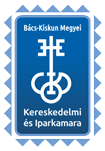Az MKIK GVI negyedéves vállalati konjunktúrafelmérésében 400 cégvezető véleményét kérdezzük a cégük üzleti helyzetéről és kilátásairól. A teljes mintára vonatkozóan, amely 300 kis- és középvállalkozást (20–249 fő között) és 100 nagyvállalkozást (250 fő felett) tartalmaz, a Negyedéves Konjunktúramutatót és a Negyedéves Bizonytalansági Mutatót közöljük. A megkérdezett kis- és középvállalkozások esetében pedig a KKV Körkép Konjunktúramutatót és a KKV Körkép Bizonytalansági Mutatót számítjuk ki. Elemzés eredményei
 Bács-Kiskun Chamber of Commerce and Industry
The key to success is – the Chamber
Bács-Kiskun Chamber of Commerce and Industry
The key to success is – the Chamber
 Bács-Kiskun Chamber of Commerce and Industry
The key to success is – the Chamber
Bács-Kiskun Chamber of Commerce and Industry
The key to success is – the Chamber